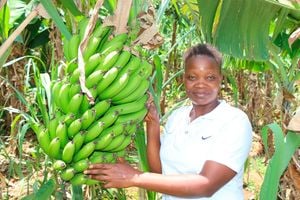
Stephen Musyoka, the General Manager Andermatt Kenya, inspects traps set to harvest Pytogard at the breeding farm in Naivasha, Nakuru County.
With lifestyle disease cases on the increase, Kenyans are being encouraged to consume organically-produced food.
A farm in Naivasha, Nakuru County, is championing natural pest control methods that could lead to healthier crops and, ultimately, healthier people.
Andermatt Kenya produces pests that prey on crop-destroying insects.
The biological method involves introducing a natural enemy of the pest into the farm ecosystem without necessarily relying on chemical interventions.
The objective is to reduce damage to crops and increase food safety through sustainable practices.
Biological control, or biocontrol, uses other organisms to control pest populations.
Predators, parasitoids, pathogens and even competitors can act as agents to limit pest numbers.
The method includes predation, parasitism and herbivory, though human intervention is necessary to maintain balance between pests and their natural enemies.
Andermatt Kenya General Manager, Stephen Musyoka, says the farm employs three strategies in the biological control of crop pests.
Classical biocontrol introduces a natural enemy of a pest with the hope that it will establish a permanent population on the farm.
The second strategy is inductive or augmentation. This involves administering large populations of natural enemies to reduce pest numbers quickly.
The third strategy is inoculative or conservation. This strategy focuses on maintaining and re-establishing natural enemies regularly to ensure ongoing control of pests.
Andermatt Kenya specialises in producing four types of beneficial predators – hypogard, caligard, amblygard and phytogard – each targeting a specific pest.
Hypogard and amblygard are effective against thrips, while caligard feeds on mites and whiteflies.
Phytogard preys on red spider mites.
Advantages of IPM
Musyoka, who is also a research agronomist, says phytogard was the first predator the farm developed due to Naivasha’s reputation for rose farming.
The climate of Naivasha is perfect for the red spider mites to thrive.
“Rose farmers had a rough time controlling these pests, often resorting to harmful chemicals. Because of that, their flowers were frequently rejected by the export markets due to high pesticide residues,” Musyoka tells Seeds Of Gold.
“Red spider mite is the main pest in greenhouses. It accounts for up to 60 per cent of the pest and disease control budgets for farmers.”
The predatory mite searches for all stages of two-spotted mites and consumes them. It is specific to its hosts.
Musyoka says Integrated Pest Management (IPM) was introduced to Kenya because of the export business more than two decades ago.
Authorities abroad demanded that the food and produce entering their territories be subjected to maximum residue level (MRL) tests.
It took time before Kenyan smallholder farmers embraced IPM, he says.
They eventually did, thanks to climate change effects and a rise in lifestyle disease cases.
With the internet and the need to eat healthy, things are changing for the better, Musyoka says.
“We should do much to control pests and diseases naturally. We need to be responsible for our environment, including what we produce for consumption and what we do to the soil, sustainably and regeneratively,” he adds.
Musyoka says biocontrol of pests and diseases on Kenyan farms has been gaining traction since the late 1990s.
“Using chemicals can harm the environment and contribute to global warming. The chemicals can also destroy important organisms like pollinators,” Musyoka says.
IPM has more advantages compared to applying chemicals to crops.
For chemical application, one must be in personal protective equipment (PPE) though there is still the risk of inhalation.
Naivasha Andermatt Kenya grows beans and other crops in greenhouses. It then introduces crop pests before bringing in the predators.
With time, the predators feed on the harmful pests as they continue to breed.
Iron rods a metre long, fitted with shredded manila strings, are inserted in between and randomly on the crop(s) before a transparent-plastic container is placed atop the rod inverted.
Musyoka says the predators usually move upwards after feeding on the pests. They climb into the container through the shredded strings.
That is how the predators are harvested.
“After harvesting, we conduct quality control or sorting. This is because some pests also climb into the container,” he says.
The harvested predators are put in different types of materials in the containers to assist in aeration and their survival.
Hypogard is mixed with cocopeat and vermiculite while caligard and amblygard are placed in wheat bran.
Phytogard is mixed with vermiculite.
Prices of predatory mites vary. With Sh1,000, a farmer can get enough to cover crops on a hectare.
“This makes it affordable to many small-scale farmers. Our goal is to encourage and support farmers take care of the environment and produce quality and healthy food,” Musyoka says.
Andermatt Kenya also trains farmers on how to use the predatory mites.
Before introduction of the beneficial mites to a farm, scouting is done to determine the population of the pests.
The bottle containing the predators is rotated gently. The lid is then opened and the predatory mite is sprinkled on the crop canopy gently.
This should take place early in the morning or late in the evening.
A farmer using IPM does not need to worry.
After the predators have destroyed the pests, they turn cannibal, thus leaving the crop green and healthy, Musyoka says.






